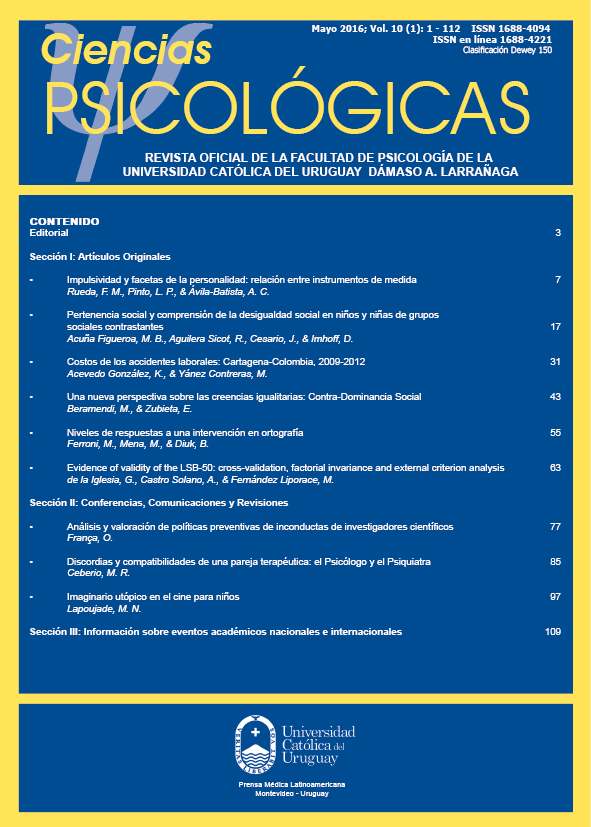DISAGREEMENT AND COMPATIBILITIES OF A THERAPEUTICAL COUPLE: PSYCHOLOGIST AND PSYCHIATRIST
DOI:
https://doi.org/10.22235/cp.v10i2.1157Keywords:
psychologist, psychiatrist, professional team, interdisciplinary, psychotherapyAbstract
One of the main problems that are built into the dynamics of psychotherapy is not strictly related to the therapist-patient relation, but specifically with the professional team. We all talk about the importance of teamwork and always talk about the virtues of interdisciplinarity, but are seldom carried into practice. Narcissism, readings and closed and particular hypothesis construction, impermeability in exchange of information, power struggle, monopoly of truths therapeutic, everything makes a whole epistemological unswerving that does not allow the interplay with other professionals. Rather, the interaction occurs on closed constructs, conceptual maps that do not support redefinitions. Beyond these digressions, it is indisputable that one of the most important couple in the art of psychotherapy is made by the pharmacologist psychiatrist and the psychologist therapist. Pair which is forcibly established by the need to medicate some cases where only psychotherapeutic treatment is ineffective. This paper discusses these issues and urges reflection on the roles of these mental health professionals.Downloads
References
Bateson G., Haley J., Weakland J. H. , & Jackson T. (1956) Hacia una teoría de la esquizofrenia. Behavioral Science, 4, 251-264.
Bateson, G. (1972). Step to an ecology of mind. NuevaYork: Ballantine.
Basaglia, F. (1968). La institución negada. Barcelona: Barral Editores.
Bascue, L. O. & Bridge, P. (2005). Documentación de la supervisión en la psicoterapia. RET: Revista de toxicomanías, 45, 27-30.
Beck, J. (2000). Terapia cognitiva. Barcelona: Gedisa.
Cacioppo, J. T. & Berntson, G. G. (Eds.), (2005). Social neuroscience: key readings. Nueva York: Psychology Press.
Cacioppo, J. T., Visser, P. S., & Pickett, C. L. (2006). Social neuroscience: people thinking about thinking people. Cambridge, MA: MIT Press.
Casari, L. M. (2013). Comparación de variables profesionales del estilo personal del terapeuta en dos grupos de psicólogos clínicos. En XIV Reunión Nacional y III Encuentro Internacional De La Asociación Argentina de Ciencias del Comportamiento.
Ceberio R. M. & Watzlawick, P. (1998). La construcción del universo. Barcelona: Herder.
Ceberio R. M. & Watzlawick, P. (2008). Ficciones de la realidad, realidades de la ficción. Barcelona: Paidós.
Ceberio M. R. & Linares J. L. (2005). Ser y hacer en terapia sistémica. Barcelona: Paidós.
Ceberio, M. R., Losada, A. V., Álvarez, L., Daverio, R., Díaz Videla, M., Fiorito, C., Locker, L., Sánchez Castañon, T., Stagliano, A., Stark, L., & Trigo, C. (2014). Colgar el diploma, ética y responsabilidad en psicoterapia. Revista Eureka 11(1), 65-76.
Chappa, H. J. (2006). Tratamiento integrativo del trastorno de pánico. Manual práctico. Buenos Aires: Paidós.
Collazos, M. V. (2007). Trastornos mentales y problemas de salud mental. Día Mundial de la Salud Mental 2007. Salud mental, 30(2), 75-80.
Cozolino, L. (2006). The neuroscience of human relationships: attachment and the developing social brain. Nueva York: W. W. Norton & Co.
Damasio, A. (1994). Descartes’ error: emotion, reason, and the human brain. Nueva York: Penguin Books.
Ferreres, V., Pena-Garijo, J., Ballester Gil de Pareja, M., Edo, S., Sanjurjo, I., & Ysern, L. (2012). ¿Psicoterapia, farmacoterapia o tratamiento combinado?: Influencia de diferentes variables clínicas en la elección del tratamiento. Revista de la Asociación Española de Neuropsiquiatría, 32(114), 271-286.
Fernández Méndez, J., Luengo Castro, M. A., García Haro, J., Cabero Álvarez, A., González Díaz, M., Braña Menéndez, B., & Caunedo Riesco, P. J. (2010). Efectividad de la psicoterapia breve en los centros de salud mental I: Diseño, tratamientos y procedimiento. Revista de la Asociación Española de Neuropsiquiatría, 30(4), 563-580.
Gazzaniga, M. S. (2008). Human: the science behind what makes us unique. Nueva York: Harper-Collins.
Garzón, D. I. (2008). Autorreferencia y estilo terapéutico: su intersección en la formación de terapeutas sistémicos. Diversitas: Perspectivas en psicología, 4(1), 159-171.
Hernández Córdoba, Á. (2007). Supervisión de psicoterapeutas sistémicos: un crisol para devenir instrumentos de cambio. Diversitas, 3(2), 227-238.
Hirsch, H. (2006). ¿Psicofármacos como psicoterapia?. Revista Argentina de Psiquiatría, 17(68), 288.
Linares, J.L. (2014). Terapia familiar ultramoderna. Barcelona. Herder.
Liria, A. F., & Vega, B. R. (2008). La era de los tratamientos integrados: Combinación de psicofármacos y psicoterapia. Revista Argentina de Clínica Psicológica, 17(2), 139-148.
LeDoux, J. E. (1993). Emotional memory systems in the brain. Behavioural brain research, 58(1), 69-79.
LeDoux, J. E. (1997). Emotion, memory and the brain. Scientific American, 7(1), 68-75.
Le Doux, J. (1999). El cerebro emocional. Planeta: Barcelona.
Loubat, M. (2005). Supervisión en psicoterapia: una posición sustentada en la experiencia clínica. Terapia psicológica, 3(2), 75-84.
Pert, C. (2003). The moleculum of emotion. New York: Scribner.
Piaget, J. (1989). La construcción de lo real en el niño. Barcelona: Crítica.
Riso, W. (2009). Terapia cognitiva. Barcelona. Paidós.
Spencer Brown, G. (1973). Laws of the form. Nueva York: Bantam Books.
Torres-Torija, J. (2009). Psicoterapia y psiquiatría: una relación paradójica. Salud mental, 32(3), 185-187.
Watzlawick, P., Beavin J. & Jackson, D. (1981). Teoría de la comunicación humana. Barcelona: Herder.
















